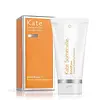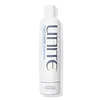What's inside
What's inside
 Key Ingredients
Key Ingredients

No key ingredients
 Benefits
Benefits

 Concerns
Concerns

 Ingredients Side-by-side
Ingredients Side-by-side

Water
Skin ConditioningLactic Acid
BufferingSilica
AbrasiveGlycine Soja Oil
EmollientPectin
Emulsion StabilisingCetearyl Alcohol
EmollientCarica Papaya Fruit
Skin ConditioningCeteareth-20
CleansingCetyl Alcohol
EmollientPhenoxyethanol
PreservativeDehydroxanthan Gum
Emulsion StabilisingGlyceryl Stearate
EmollientPEG-100 Stearate
Salicylic Acid
MaskingLactobacillus/Pumpkin Ferment Extract
Skin ConditioningAlcohol Denat.
AntimicrobialSorbic Acid
PreservativeCinnamal
PerfumingMel
EmollientCitrus Aurantium Bergamia Fruit Oil
MaskingEugenol
PerfumingPotassium Sorbate
PreservativeLimonene
PerfumingLinalool
PerfumingLavandula Angustifolia Oil
MaskingBeta-Carotene
Skin ConditioningAloe Barbadensis Leaf Juice Powder
Skin ConditioningBromelain
Skin ConditioningPapain
Skin ConditioningRetinyl Palmitate
Skin ConditioningTocopheryl Acetate
AntioxidantCinnamomum Cassia Leaf Oil
MaskingAcetic Acid
BufferingPogostemon Cablin Leaf Oil
MaskingPelargonium Graveolens Flower Oil
MaskingAniba Rosaeodora Wood Extract
MaskingCitrus Aurantium Dulcis Peel Oil
MaskingCI 75810
Cosmetic ColorantWater, Lactic Acid, Silica, Glycine Soja Oil, Pectin, Cetearyl Alcohol, Carica Papaya Fruit, Ceteareth-20, Cetyl Alcohol, Phenoxyethanol, Dehydroxanthan Gum, Glyceryl Stearate, PEG-100 Stearate, Salicylic Acid, Lactobacillus/Pumpkin Ferment Extract, Alcohol Denat., Sorbic Acid, Cinnamal, Mel, Citrus Aurantium Bergamia Fruit Oil, Eugenol, Potassium Sorbate, Limonene, Linalool, Lavandula Angustifolia Oil, Beta-Carotene, Aloe Barbadensis Leaf Juice Powder, Bromelain, Papain, Retinyl Palmitate, Tocopheryl Acetate, Cinnamomum Cassia Leaf Oil, Acetic Acid, Pogostemon Cablin Leaf Oil, Pelargonium Graveolens Flower Oil, Aniba Rosaeodora Wood Extract, Citrus Aurantium Dulcis Peel Oil, CI 75810
Water
Skin ConditioningSodium Cocoyl Isethionate
CleansingSodium Lauroyl Sarcosinate
CleansingCocamidopropyl Betaine
CleansingDisodium Laureth Sulfosuccinate
CleansingGlycereth-26
HumectantDivinyldimethicone/Dimethicone Copolymer
Cocamidopropylamine Oxide
CleansingAcrylates Copolymer
PEG-90 Glyceryl Isostearate
CleansingParfum
MaskingPPG-5-Ceteth-20
EmulsifyingPanthenol
Skin ConditioningQuaternium-80
Hydrolyzed Vegetable Protein Pg-Propyl Silanetriol
Skin ConditioningSodium Lauroamphoacetate
CleansingSodium Methyl Cocoyl Taurate
CleansingGlycol Distearate
EmollientPolyquaternium-10
Polyquaternium-22
Laureth-2
CleansingC12-13 Pareth-23
CleansingC12-13 Pareth-3
EmulsifyingLauryl Methyl Gluceth-10 Hydroxypropyldimonium Chloride
Decylene Glycol
Skin ConditioningCaprylyl Glycol
EmollientCinnamidopropyltrimonium Chloride
Phenoxyethanol
PreservativeCitric Acid
BufferingSodium Benzoate
MaskingCoconut Acid
CleansingSodium Isethionate
CleansingLaureth-3
EmulsifyingSodium Sulfate
Benzoic Acid
MaskingGlycerin
HumectantTrideceth-12
EmulsifyingPropylene Glycol
HumectantBenzyl Alcohol
PerfumingBenzyl Benzoate
AntimicrobialBenzyl Salicylate
PerfumingCinnamyl Alcohol
PerfumingCinnamal
PerfumingCitral
PerfumingCitronellol
PerfumingLimonene
PerfumingEugenol
PerfumingFarnesol
PerfumingGeraniol
PerfumingHexyl Cinnamal
PerfumingHydroxycitronellal
PerfumingIsoeugenol
PerfumingLinalool
PerfumingWater, Sodium Cocoyl Isethionate, Sodium Lauroyl Sarcosinate, Cocamidopropyl Betaine, Disodium Laureth Sulfosuccinate, Glycereth-26, Divinyldimethicone/Dimethicone Copolymer, Cocamidopropylamine Oxide, Acrylates Copolymer, PEG-90 Glyceryl Isostearate, Parfum, PPG-5-Ceteth-20, Panthenol, Quaternium-80, Hydrolyzed Vegetable Protein Pg-Propyl Silanetriol, Sodium Lauroamphoacetate, Sodium Methyl Cocoyl Taurate, Glycol Distearate, Polyquaternium-10, Polyquaternium-22, Laureth-2, C12-13 Pareth-23, C12-13 Pareth-3, Lauryl Methyl Gluceth-10 Hydroxypropyldimonium Chloride, Decylene Glycol, Caprylyl Glycol, Cinnamidopropyltrimonium Chloride, Phenoxyethanol, Citric Acid, Sodium Benzoate, Coconut Acid, Sodium Isethionate, Laureth-3, Sodium Sulfate, Benzoic Acid, Glycerin, Trideceth-12, Propylene Glycol, Benzyl Alcohol, Benzyl Benzoate, Benzyl Salicylate, Cinnamyl Alcohol, Cinnamal, Citral, Citronellol, Limonene, Eugenol, Farnesol, Geraniol, Hexyl Cinnamal, Hydroxycitronellal, Isoeugenol, Linalool
Ingredients Explained
These ingredients are found in both products.
Ingredients higher up in an ingredient list are typically present in a larger amount.
Cinnamal is an aromatic aldehyde. It is naturally occurring in the spice known as cinnamon.
Cinnamal is a known EU allergen, meaning it may cause an allergic reaction when applied to the skin.
Eugenol is naturally found in cloves, basil, and bay leaves. It is an aromatic oil used to add fragrance to a product. The scent of eugenol is described as "clove-like". Eugenol is a known EU allergen, meaning it causes contact allergies.
Studies show eugenol possesses antibacterial and antioxidant properties.
Besides cosmetics, eugenol is also added as a flavor in teas and cakes.
Learn more about EugenolLimonene is a fragrance that adds scent and taste to a formulation.
It's found in the peel oil of citrus fruits and other plants such as lavender and eucalyptus. The scent of limonene is generally described as "sweet citrus".
Limonene acts as an antioxidant, meaning it helps neutralize free radicals.
When exposed to air, oxidized limonene may sensitize the skin. Because of this, limonene is often avoided by people with sensitive skin.
The term 'fragrance' is not regulated in many countries. In many cases, it is up to the brand to define this term. For instance, many brands choose to label themselves as "fragrance-free" because they are not using synthetic fragrances. However, their products may still contain ingredients such as essential oils that are considered a fragrance.
Learn more about LimoneneLinalool is a fragrance and helps add scent to products. It's derived from common plants such as cinnamon, mint, citrus, and lavender.
Like Limonene, this ingredient oxidizes when exposed to air. Oxidized linalool can cause allergies and skin sensitivity.
This ingredient has a scent that is floral, spicy tropical, and citrus-like.
Learn more about LinaloolPhenoxyethanol is a preservative that has germicide, antimicrobial, and aromatic properties. Studies show that phenoxyethanol can prevent microbial growth. By itself, it has a scent that is similar to that of a rose.
It's often used in formulations along with Caprylyl Glycol to preserve the shelf life of products.
Water. It's the most common cosmetic ingredient of all. You'll usually see it at the top of ingredient lists, meaning that it makes up the largest part of the product.
So why is it so popular? Water most often acts as a solvent - this means that it helps dissolve other ingredients into the formulation.
You'll also recognize water as that liquid we all need to stay alive. If you see this, drink a glass of water. Stay hydrated!
Learn more about Water